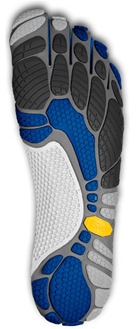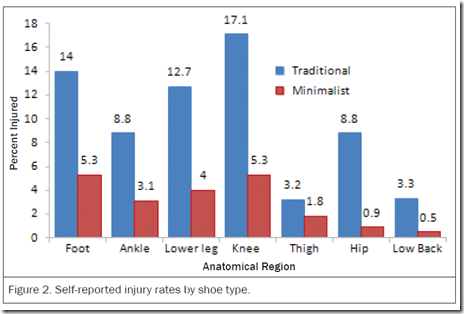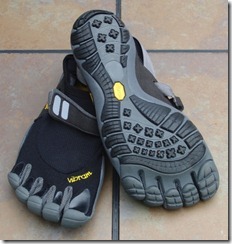 Image by Getty Images via Daylife
Image by Getty Images via DaylifeAbout a month and a half ago I ran my first fully barefoot run, and it was clear from the comments I received on that post that I had picked a horrible set of conditions in which to do so. It was cold, wet, and dark, and there was pretty much nothing about the experience that I enjoyed other than the fact that I could say that I did it. I pledged that I would give it another try, so tonight I finished off my run with 1.5 miles fully barefoot. This was a mile longer than I ran last time, but aside from my skin not being used to the abrasion, my feet and legs were more than up for the distance (I’ve been running in Vibram Fivefingers regularly since last summer).
My thoughts this time around were much more positive, though I still would say that barefoot running is not for me. Tonight was dry and warm, so that in and of itself was a major improvement. The sensation of running barefoot was for the most part enjoyable this time around, though I still had issues with hitting small pebbles that would send shooting pain through my foot. Also, I discovered that some forms of asphalt have a rougher texture that really chews away at your skin – if I could be guaranteed a nice, pre-swept stretch of smooth asphalt every time I ran barefoot, I might consider doing it more often, but those pesky pebbles are a major deterrent for me. In addition to the asphalt sidewalk, I also ran on grass for a small stretch, and that felt really good – I could easily see myself doing barefoot strides on grass more frequently.
Perhaps my biggest reason for not seeing myself as a barefooter gets back to a point I made in my post following my first barefoot run – I just don’t see the training benefit beyond just running pain-free in my Vibrams. I get the tactile feedback argument, and how it helps with the development of proper form, but when tactile feedback includes shooting pebble pain that can be avoided by wearing Vibrams, that’s where the argument loses its appeal for me. I can totally understand the reasons why people run barefoot regularly, and I’m glad that I gave it another try, but I don’t think it’s going to be a regular part of my running routine. I’m still a committed minimalist runner, and I’ll continue to post about barefoot running, but I’ll likely leave the actual barefooting to those dedicated runners who are willing to put up with a bit of pain while they build thicker skin on the soles of their feet.
![Reblog this post [with Zemanta]](https://img.zemanta.com/reblog_e.png?x-id=e5849fdb-bf98-4f11-b9c0-057c400702ab)



















I actually haven’t tried going completely barefoot yet, mainly because of the reasons you mention. I run with some Feelmax shoes, and even with soles – albeit extremely thin ones – stepping on pebbles is painful.
I’m thinking of having my first barefoot run on the track instead of outdoors.
Grass or a track would be a good choice. Asphalt isn’t bad for the
most part, it’s just that when you hit a pebble, it really hurts!
Pete
Sent from my iPod
I’ve found the track (at least the track I go to) much worse than concrete – even with the pebbles. My take is a number of skills need to be learned to run barefoot – and careful scanning with your eyes is one.
Sounds like you gave it a fair shot.
Ideally, we go through the ouch, ouch phase when we’re little, and maintain that foot toughness for our whole lives. It is tough building it up as an adult. You can do it, of course, but it requires a dedicated effort.
I figured I at least needed to try it – nothing ventured, nothing gained
right? Unfortunately, I think the effort required to toughen my feet up is
not one that I am going to make.
Pete
good article, I think running barefoot on grass doing strides is a good way to make feet stronger and improve form but even the born to run tribe wear car tyres on there feet
http://petemagill.blogspot.com…
and every top kenyan runner since the 60’s races in shoes, even cavemen made shoes out of animal skin!
And how many barefoot runners break 3.00 for the marathon ???
Rick,
I tend to agree – there’s clearly a reason why humans started wearing things
on the soles of their feet, whether it be animal skin, sandals, huaraches,
etc. I also don’t see any way that I could run faster barefoot than I do in
shoes if I constantly need to be on the lookout for debris on the ground so
that I don’t step on something that’s going to hurt. Wearing shoes (and I
prefer them to be minimalist) allows me to enjoy my surroundings more and
worry less about what I might step on.
Pete
I too, just finished my second barefoot run. 2.2 miles each time. I need to note that I am NOT a good runner, so I was pretty proud of myself for these runs! I brought flip flops along just in case i ran into dangerous terrain (lots of sticks/pebbles, etc.) but found I didn’t need them. I did experience the occasional pesky pebble, but none of them too painful, and they were gone on the following step. I actually expected my first couple times out to be much more painful. What I did notice however was the extreme tightness/soreness on the very top of the calf. I had read that you needed to work into barefoot running slowly, but I thought that was about your feet. I didn’t realize it was really about how differently your body accepts the weight and motion when you are barefoot. I am happy to report that my pretty little wide feet are still free of blisters, cuts, or any other surface injury. I haven’t tried the vibrams–I’ve kind of had a mental thing about spending money on something that is designed to replicate nothingness. :-)
Stephanie,
Thanks for the comment! The calf soreness is something almost everybody who
does barefoot or Vibram runs experiences. The lack of a cushioned heel
really works you out in a different way than your body is used to. My main
reason for being willing to pay up for the Vibrams is that they offer
protection and do the best job of any shoe out there in actually working
with the real anatomy of your foot.
Pete
Hey Pete,
Do you have a video of you barefoot running on a treadmill?
Zoe,
I do – here it is: link to youtube.com…. I have a
bunch more that aren’t on-line yet – hope to get them up soon.
Pete
I am pretty much on board with this. I’ve tried some barefoot runs and on grass I do it a little bit still–did a couple of miles yesterday–but on roads the skin gets very, very chewed up and I could see it taking many months to get to the point I could tolerate any real miles. By then of course the snow is almost here and I’m back to shoes anyway. Not to mention even on trails when I run with my VFF (and I must say I love them in this environment) even still every couple of runs I’ll get a rock stabbing my big toe or something. Not the end of the world but in a way I see shoes like VFF to feet as clothes are to our body; they’re just better. It’s very difficult living in modern society to toughen the feet up to a degree they should be fore barefooting and I’m not going to be evangelical about it as some are, wearing them out to stores and things like that.
Jimson,
Thanks for your comment – seems we’re very similar in or positions on
barefooting!
Pete
I got my Vibram KSO’s about 8 months ago and wore them walking and to the store and out hiking the trails with my dog for a few weeks and then started running in them. After several 2-9 mile runs in them (now for 5+ months) I have recently (November) incorporated barefoot running into my routine. I started with 2 miles, then 3, then 4 and now I just take my Vibrams or my homemade huaraches with me and did 7 miles the other day at a 9:00 pace. I run mostly on clean concrete and asphalt sidewalks and running trails (some are pretty rough) when I am barefoot and have built up to being able to choose from many types of footwear or go without. I recommend starting your runs, 5-10 minutes, barefoot then putting your choice of shoe on and continuing then trek. After a few runs it should be easy to increase the distance and/or time on your barefeet. Although maybe it just isn’t for you in the end! Either way, start your runs on clean, well lighted, hard surfaces that are without pebbles, glass etc…good luck, just don’t give up too soon…it will grow on you…
I tried barefoot running last spring/summer. My longest run was 6 miles. I was new to runnIng and my stability shoes made my feet fall asleep. I was pretty broke and had a brand-new, worthless pair of pro-grid guide 3’s. I could not afford VFFs. I bought $8 aqua-socks from Walmart and pulled out the insoles. It was a definite adjustment, but also an improvement. I decided to try going full-on barefoot and it was exhilarating, until I zoned out for a second and stepped on a stone. That lump in my foot lasted a month. Once it healed, I went again. 4 miles into that 6 mile run, I stubbed my toe and split it wide open. It was bleeding bad, but I was 2 miles from home, so I just toughed it out and ran home. The month that it took that to heal was VERY painful. When My foot healed, I took my 5 year old daughter to the local HS rubber track. A half hour into the run, I stumbled and dragged the top of my other toe across the track surface, removing a big flap of skin from the top of the other big toe, adjoining the toenail. After another month of pain, I decided that I am too clumsy for barefoot running. Two weeks after I finally bought VFFs, I tripped, and supermanned across the pavement, tearing the left toe of my long-awaited Vibrams. I still run in them like that, and I don’t plan on running in shoes ever again.
Yikes, what a story! I admire your diligence! I hope I have the same. I did something similar today. see my post here: link to runblogger.com…
If you get the chance to run barefoot on a firm, smooth beach, do it. I went out to Tofino, BC, and got a couple of short runs in on Chesterman’s and Cox Bay at low tide. The absence of a weight on my feet felt amazing, and the surface was free of stones yet firm enough so that it didn’t feel like a slog. The key is to find a firm, smooth beach, not running through loose sand or across a sidehill. Way better than those stupid Newtons – I can’t run at all now because of the hip injury I’d sustained after my first couple of short runs in those torture devices.